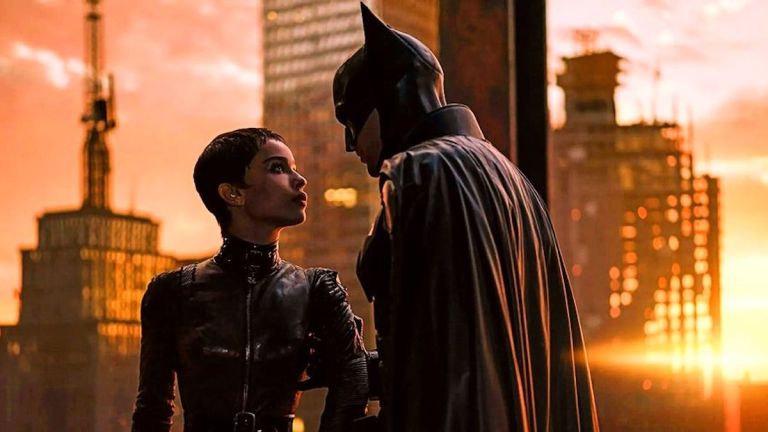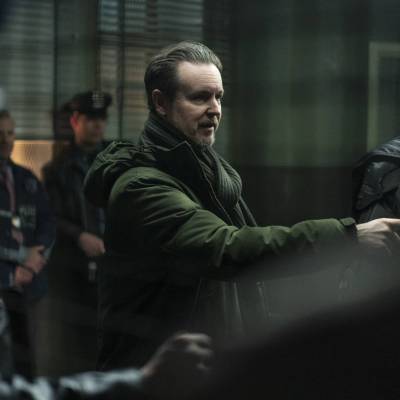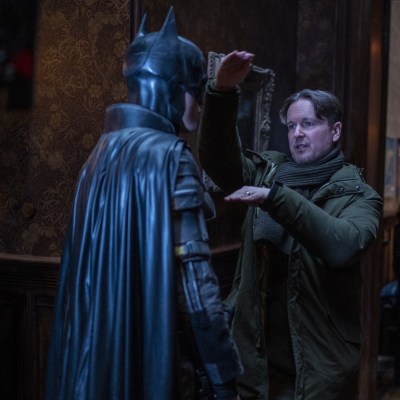The Batman Ending Explained
We dive into the complex mystery and its larger implications for The Batman… and beyond.

This article contains major The Batman spoilers. Our spoiler-free review is here.
We’ve witnessed this scene before in a Batman movie. A Dark Knight and his feline companion stand by a motorcycle, parting ways for what feels like forever—but probably won’t be. It’s the final scene in Matt Reeves’ sinewy The Batman, and it echoes a similar moment from Christopher Nolan’s The Dark Knight Rises (2012): Catwoman asks Batman to come with her and give up on this hellhole they call a city; he refuses.
Yet for all the similarities, the context is wholly different. In Nolan’s final Batman movie, such a moment was at the last gasp of Bruce Wayne’s war on crime, an admission that he wants to go but cannot. But the Robert Pattinson version of the same character in this weekend’s The Batman? For the first time in the whole film, he realizes there is something bigger than his own trauma, his own pain, and is only right now truly beginning his caped crusade.
Rather than an ending, it’s a renewed start, and rather than a tease for romance, it’s a bitter acknowledgement that we—the audience and Pattinson’s Bruce—have only begun to understand what fresh hell we’re in. After three hours of anguish and violence, it is both a moment of hope and resignation, one that casts everything that came before it in a new light. Here’s how it came to this.
The Riddler’s Connection to Thomas Wayne
Every villain thinks they’re the hero of their own story, and that is rarely more true than for Paul Dano Dano’s sad, and ultimately pathetic, interpretation of the Riddler. As we slowly discover, he doesn’t think he’s taunting the Batman like the Zodiac Killer mocked the real San Francisco police force; he thinks he’s collaborating with Batman by punishing the city and calling down a veritable biblical flood. (We wrote more on the Riddler’s similarities to the Zodiac Killer here)
This is echoed by the Riddler’s backstory since he very much is intended to mirror Bruce Wayne. Like Bruce, Riddler, aka Edward Nashton, is an orphan—a child left behind by a cruel world and even crueler man-made systems. Yet unlike Bruce Wayne, the “poor orphan” who still inherited untold billions of dollars and grew up able to indulge his passions (i.e. crimefighting), the high point of Edward’s life before he became the Riddler appeared to be when he was used as a campaign prop by Thomas Wayne a week before the Waynes’ murder.
As we eventually learn, young Edward was one of the children in the orphanage behind Thomas when he announced his mayoral candidacy and pledged to donate a dazzling $1 billion to a renewal fund for the city. However, as Ed tells Batman during his interrogation, a week later Thomas and his wife Martha were murdered, and like so many other of the best laid civics plans, the renewal fund never invested in Ed’s orphanage. In fact, by the time he reached his 30s as a meek and lowly accountant for the city, he discovered that with Thomas Wayne long dead, his money had become a slush fund for corruption, be it from the mob to D.A.s and cops on the take.
That is the epiphany that allowed Edward to become Riddler, and the knowledge he used to enact his terrible scheme to expose all of the city’s corruption from the failed urban renewal: the mayor, the D.A., and even out of spite Bruce Wayne (luckily Riddler never figured out his imaginary BFF, Batman, is his rich kid doppelgänger).
This provides an interesting context for the film to directly challenge the privilege the Bruce Wayne character is always presented as enjoying, and unlike previous Batman movies, it exposes the limits of his good intentions with even Thomas Wayne’s best efforts being corrupted—just like the actual man (more on that below). It also provides a pathway to connect the Riddler to the most powerful man in Gotham City…
Carmine Falcone, The Ultimate Rat
Much of the mystery at the heart of The Batman is about who is the rat? Who is the D.A. informant that gave career-making intel to D.A. Gil Colson (Peter Sarsgaard) that put the unseen second biggest gangster in the city, Sal Maroni, in prison? As it turns out, it was the No. 1 mafioso, Carmine Falcone (John Turturro).
In a highly satisfying twist, Reeves and Peter Craig’s screenplay reveals that Colson’s best informant, and whom the Riddler discovered through the renewal fund’s books, is none other than a gangster himself who was using the cops to silence the opposition—not clean up the city. The twist is clearly based on Whitey Bulger, one of the most powerful organized crime leaders in Boston for over 20 years. And during most of that reign he was an informant to the FBI, using the feds to wipe away enemies and keep himself out of prison. When the scandal was finally exposed in 1995, he went on the lam until his arrest in 2011. He was then mysteriously found murdered in his prison cell in 2018. Incidentally, the first half of that story inspired Jack Nicholson’s Frank Costello in The Departed.
As Colin Farrell’s Penguin ultimately tells Carmine after it comes out he was the informant who flipped on Maroni: no one likes a rat. That’s why for most of the movie you should take everything Carmine said with a grain of salt.
For instance, his corruption of Thomas Wayne. When Bruce finally storms into Falcone’s office for answers about his father, Falcone peppers the truth with lies and omissions. Thomas really did come to Falcone for help because a reporter was going to reveal hidden family gossip about Martha’s battles with mental illness. (Maybe that explains why Pattinson’s Bruce is so moody?) Carmine says Bruce’s father asked him to “take care” of the journalist. Now the crime boss was fully in bed with the city father. Afterward, according to Carmine, Maroni likely put a hit on Thomas and Martha because he knew Falcone now “owned” the next mayor of Gotham City.
However, as we later learn from Alfred (Andy Serkis), Thomas only wanted Falcone to scare the reporter, and when Thomas realized what Falcone had done he planned to go to the authorities. Hence the suggestion that Falcone probably had Thomas and Martha killed. Like some versions of the comics, none of the good guys know for certain who actually killed the Waynes—a question mark that could come up in future movies—but the point remains Falcone manipulates everyone, including Bruce Wayne who he brought closer to his orbit with lies about his Bruce’s parents.
This also exposes Bruce for the naive and narrow view he had about the world. He thinks there’s only right and wrong, himself and Selina Kyle (Zoë Kravitz) at the beginning of the movie. Yet as Selina tells Batman, his judgmental attitude belies he came from money. The world is more complex, and even his saintly father turned out to have a devil on his shoulder. That devil just happened to be named Falcone.
Indeed, Falcone will lie and kill to stay on top. It’s why he murdered Selina’s friend after he realized she could unintentionally finger him as Colson’s informant. And it’s honestly easy to imagine he might’ve been able to get away with it if Gotham’s tainted legal system had gotten their hands on him. Perhaps Bruce should’ve let Selina kill her old man?
The Riddler’s Endgame—and Betrayal of the Movie
Falcone’s treachery, and the city’s complicity is the thread that drove the Riddler over the edge. But he wasn’t alone. If Edward’s one big mistake is thinking he found a kindred spirit in the Batman—mistaking their communications over the internet as a game instead of a hunt—he didn’t misunderstand his other fellow travelers.
In the big twist of the movie’s finale, it turns out the Riddler (like a certain Joker in another Batman universe) wanted to get caught, and planned all along to wipe out Gotham City by blowing its levees and causing the city to flood. The development is taken straight out of Scott Snyder and Greg Capullo’s Batman: Zero Year, but it plays like a more modern blockbuster with the city facing an existential threat, even as the Riddler’s muscle he met on the dark web turn out to be incel fanatics who carry assault rifles into a public place—planning a mass murder.
If I’m being honest, this entire climax doesn’t really work. In essence, it feels like a sequence out of one of Christopher Nolan’s The Dark Knight films, and not just because of the repeated plot point of the evil genius allowing himself to be caught so he can meet Batman face-to-face and reveal his master plan. The Riddler thinking he is in “a fight for Gotham’s soul,” or worse planning to destroy the city, is pretty much a tonal and narrative break from everything we watched in the film’s first two and a half hours.
The ending of the movie might’ve been more satisfying if after Falcone is assassinated by the Riddler, Edward still gives himself up to just put all the pieces together for Batman and reveal he always was ahead of the Great Detective the whole time—think John Doe in Se7en but without someone’s head in a box.
Instead we get a Nolan-esque ending where instead of the supervillains standing in for terrorists, they now stand in for alt-right and lone wolf maniacs whom the Batman must save the mayor from… and then like Moses (or Noah) literally lead the civic leaders out to a brighter dawn. Given the heinous corruption of all the civic leaders we met in the movie, it’s a false note. But it does at least provide a good reason for…
Why Batman Stays
So we’re again at those final moments where Bruce and Selina walk among the dead of Gotham City and debate what to do next. With her criminal father finally in the ground, Selina is done with this city and off to hopefully find somewhere sunny, warm, and fun. But Batman cannot leave.
As we mentioned at the top, that isn’t because he’s resigned himself to his glum fate of seeing this mission through to the bitter end. Instead, for the first time in the whole three-hour film, he’s realizing his mission can be about more than himself. When we meet Pattinson’s Batman he literally refers to himself as “Vengeance.” For him, this is all personal; a way to work through his trauma.
But when he realizes that the Riddler’s incel buddies also call themselves “Vengeance,” he sees the dark and lonely path he’s on can inspire hate, anger, and violence. He then also sees he can lead the civic leaders of Gotham out of the flood. In that moment, he truly understands his capacity for good. He can inspire Gotham to figuratively and literally wash away the sins of their fathers. Bruce has to stay now, and actually see if he can help his city instead of himself.
The Joker Gets the Last Laugh
While Bruce’s choice to stay is the ending, there is also what amounts to a glorified post-credits scene slipped in before the final cut to black: our introduction to Barry Keoghan’s the Joker. In another move taken from Nolan’s playbook, the first entry in this rebooted universe includes a tease in its closing moments to the Clown Prince of Crime.
And in the case of The Batman, we get a kind of good look at him through a prison door. Unlike Ledger’s Joker in The Dark Knight, it appears Keoghan’s big bad is fully formed before ever meeting Batman. He’s already in Arkham Asylum and has a face that appears to be disfigured by more than a chemical bath.
When our editor-in-chief Mike Cecchini spoke with Matt Reeves last month, the director confirmed that the Joker was disfigured from birth in a change that echoes Gothic horror and German Expressionism that influenced the creation of the Joker: Paul Leni and Conrad Veidt’s 1928 silent classic, The Man Who Laughs.
“The idea is that what you’re seeing is a pre-Joker, Joker actually,” Reeves tells us. “So it will be critical that he be different. And for me, I was working with Mike Marino who did Colin’s makeup, and he did Barry [Keoghan]’s makeup as well. The conception that I wanted was that we’d go back to the Conrad Veidt, The Man Who Laughs inspiration, which is the Bob Kane, Bill Finger reference [for the character]. And in that, obviously that guy has a congenital disease. He’s like the Phantom of the Opera, he can’t not smile. So I was like, ‘wouldn’t it be interesting if this origin was not like, you know, a vat of chemicals or some unexplained sort of scars like the Nolan Joker?’ What if we did something where he had a congenital disease?’”
Reeves goes on to similarly compare it to the real-life historical figure John Merrick, aka “the Elephant Man.” A man disfigured at birth and referred to any number of slurs, Merrick’s life story was hauntingly made into a David Lynch film that Reeves also considers a touchstone. Only instead of becoming a symbol for the best of humanity, Reeves imagines his Joker takes all the slings and arrows and transforms them into fuel for his nihilism.
Says Reeves, “He would have a kind of insidious understanding of human nature and everything was framed through that lens of fate playing a cruel joke on you from childhood.”
With that said, be aware the director will not confirm (yet) whether this means for certain we’ll see the Joker in his sequel, assuming one is made.
“His appearance at the end of the movie is really more contextual,” Reeves explains. “I can’t say whether we would do him specifically in the movies or not.”
We imagine fans may be very interested though to see where this departure from previous Jokers could go…and we have more on those possibilities here.


